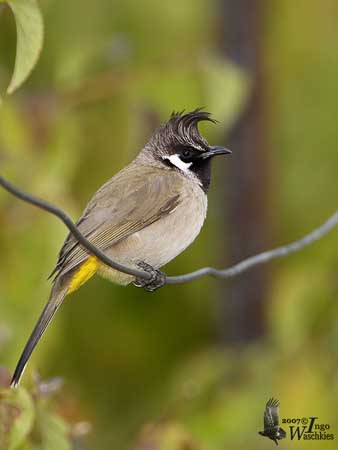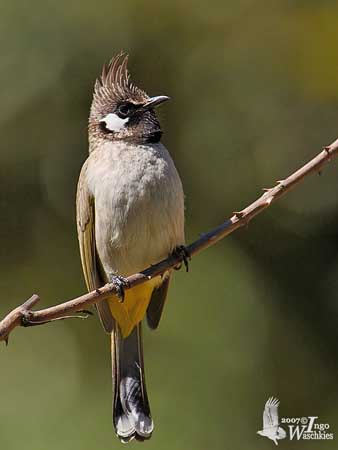
Fr: Bulbul à joues blanches
All : Weißohrbülbül
Esp : Bulbul de Mejillas Blancas
Ital : Bulbul guancebianche
Nd : Witwangbuulbuul
Russe : Белощекий бюльбюль
Sd : Himalayabulbyl
Photographer:
Ingo Waschkies
Bird Photography
Text by Nicole Bouglouan
Sources :
HANDBOOK OF THE BIRDS OF THE WORLD Vol 10 by Josep del Hoyo-Andrew Elliott-David Christie - Lynx Edicions - ISBN: 8487334725
BIRDS OF THE MIDDLE EAST by R.F. Porter, S. Christensen, P Schiermacker-Ansen C.Helm - ISBN: 0713670169
L’ENCYCLOPEDIE MONDIALE DES OISEAUX - Dr Christopher M. Perrins - BORDAS - ISBN: 2040185607
Wikipedia, the free encyclopaedia
Himalayan Bulbul
Pycnonotus leucogenys
Passeriforme Order – Pycnonotidae Family
BIOMETRICS:
Length: 18 cm
Wingspan: 25-28 cm
Weight: 34-38 g
DESCRIPTION:
Himalayan Bulbul is a greyish brown bulbul, with conspicuous white cheeks which contrast with the entirely black hood.
The mountain variety has a crest on its head, while those in the plains don’t have it.
The bright yellow undertail-coverts contrast noticeably with the white underparts.
It has a black head and throat, with bold white blaze below eye, over cheeks and on the sides of neck.
The upperparts are dull grey with darker flight feathers, and black-brown tail whose feathers show terminal white spots.
The chest is pale dusky-brown. The underparts are pale grey-buff, almost grey-white on rear flanks. Vent is rich yellow.
Eyes are red-brown, with narrow yellow eye ring. It has black bill and legs.
Both sexes are similar.
Juvenile has duller, browner head than adult.

VOICE: SOUNDS BY XENO-CANTO
Himalayan Bulbul’s song is generally melodious. That is a liquid, bubbly, chattering, seemingly a repetition of the phrase “oo-toodle-oo”. Alarm call is a sharp “pit”.
HABITAT:
Himalayan Bulbul lives in subtropical areas, in warm dry areas from coastal mangroves to 2000 metres. It prefers broader valleys, or side valleys and hills, where climatic barrier is reached. It is a bird of open countries, not of forest, and it likes bushes rather than trees.
It breeds in wooded valleys and bushy hillsides. It is also found in cities, parks and gardens. It can be seen up to 300 to 2400 metres of elevation and higher if there are fruiting trees.
RANGE:
Himalayan Bulbul lives in Himalaya, from north-western India to southern Iran.
BEHAVIOUR:
Himalayan Bulbul catches insects on the ground. It also hawks flying insects. It starts the pursuit from a perch, often in the evening.
It likes bushes to perch. We can see small flocks in the hedges in villages, and it is often found in pairs. It is a bold and familiar bird, often entering into houses to steal some bread’s crumbs on tables.
It perches on bush top, bowing, fluttering wings and tail, and constantly uttering calls in series.
Himalayan Bulbul is essentially resident, though populations of Himalayan foothills have some local upward altitudinal movement to find food.
It is a garden and park bird, but also found in high mountains. It is an energetic and noisy bird.
FLIGHT:
Himalayan Bulbul has an agile flight to chase insects from perches.
REPRODUCTION:
Himalayan Bulbul’s nest is located in a low bush, or sometimes, in branches of low tree. It’s a substantial cup of grass, stems, and leaves, roots, and thin twigs, built by the female. Nest is lined with finer rootlets, lichens and grass. It is located between 50 cm and 3 metres above the ground.
Female lays 2 to 5 eggs. Incubation lasts 12 days, mainly by female, but young are fed by both parents.

DIET:
Himalayan Bulbul eats mainly insects, fruit and berries, seeds, buds and nectar.
PROTECTION / THREATS / STATUS:
Himalayan Bulbul is not globally threatened. It is widespread and common. This species benefits from the deforestation and comes near human habitations.
It may be classified as crop pest in some regions where it damages the crops of small fruits.